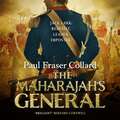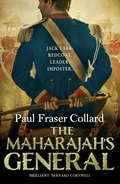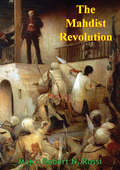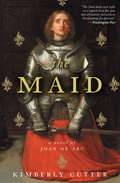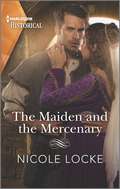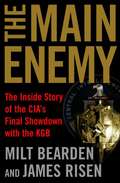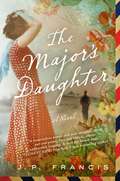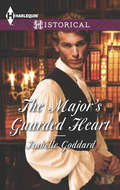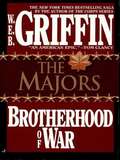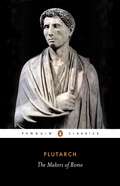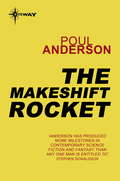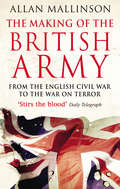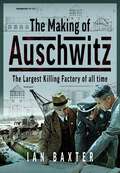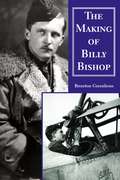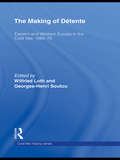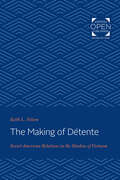- Table View
- List View
The Maharajah's General (Jack Lark, Book 2): A fast-paced British Army adventure in India
by Paul Fraser CollardIn The Maharajah's General by Paul Fraser Collard Jack Lark returns to the battlefield under a new name to face greater adventures in a brutal land. A must-read for fans of Bernard Cornwell and Simon Scarrow. 'Collard ... evokes the horror of that era with great brio. Enthralling' The TimesJack Lark barely survived the Battle of the Alma. As the brutal fight raged, he discovered the true duty that came with the officer's commission he'd taken. In hospital, wounded, and with his stolen life left lying on the battlefield, he grasps a chance to prove himself a leader once more. Poor Captain Danbury is dead, but Jack will travel to his new regiment in India, under his name.Jack soon finds more enemies, but this time they're on his own side. Exposed as a fraud, he's rescued by the chaplain's beautiful daughter, who has her own reasons to escape. They seek desperate refuge with the Maharajah of Sawadh, the charismatic leader whom the British Army must subdue. He sees Jack as a curiosity, but recognises a fellow military mind. In return for his safety, Jack must train the very army the British may soon have to fight...(P)2013 Headline Digital
The Maharajah's General: A fast-paced British Army adventure in India (Jack Lark, Book #2)
by Paul Fraser CollardIn The Maharajah's General by Paul Fraser Collard Jack Lark returns to the battlefield under a new name to face greater adventures in a brutal land. A must-read for fans of Bernard Cornwell and Simon Scarrow. 'Collard ... evokes the horror of that era with great brio. Enthralling' The TimesJack Lark barely survived the Battle of the Alma. As the brutal fight raged, he discovered the true duty that came with the officer's commission he'd taken. In hospital, wounded, and with his stolen life left lying on the battlefield, he grasps a chance to prove himself a leader once more. Poor Captain Danbury is dead, but Jack will travel to his new regiment in India, under his name.Jack soon finds more enemies, but this time they're on his own side. Exposed as a fraud, he's rescued by the chaplain's beautiful daughter, who has her own reasons to escape. They seek desperate refuge with the Maharajah of Sawadh, the charismatic leader whom the British Army must subdue. He sees Jack as a curiosity, but recognises a fellow military mind. In return for his safety, Jack must train the very army the British may soon have to fight...
The Mahdist Revolution
by Major Robert N. RossiThis paper analyzes the Mahdist Revolution in the Sudan from 1881 to 1885. Mohammed Ahmed bin Abdallah proclaimed himself the Mahdi (the expected one or the deliverer in the Islamic faith) and fought the colonial Egyptian government of the Sudan and the British. Britain was drawn into the conflict by its interest in the Suez Canal, its heavy financial investments in Egypt, and its participation in suppressing the Arabi revolt.Mohammed Ahmed successfully defeated the Egyptian and British forces brought against him and established an Islamic state in the Sudan. He succeeded by effectively combining religious, economic, cultural, and military strategy under charismatic leadership.
The Maid the Greek Married (The Xenakis Reunion #2)
by Jackie AshendenIn this captivating marriage of convenience from Jackie Ashenden, will saying &“I do&” save Cinderella and the billionaire? She owes him her life……and vows to wear his ring!Imprisoned on a compound since childhood, housemaid Rose has no recollection of anything before. So when she learns superrich Ares Aristiades needs a wife, she proposes a deal: her freedom in exchange for marriage!Before binding her to him permanently, Ares gives virgin Rose a year to experience being his bride. His mansions across the globe are hers to share, but the hardened widower&’s heart is locked away. Still, their charged encounters make Ares feel far too much. Especially when he doesn&’t want to feel anything at all…From Harlequin Presents: Escape to exotic locations where passion knows no bounds.Read all The Xenakis Reunion books:Book 1: The Innocent's One-Night ProposalBook 2: The Maid the Greek Married
The Maid: A Novel of Joan of Arc
by Kimberly CutterA &“stunning&” novel of Joan of Arc, the fifteenth century teenage visionary who led an army and saved France (Publishers Weekly, starred review). The tumultuous Hundred Years&’ War rages on and France is under siege. English soldiers tear through the countryside destroying all who cross their paths, and Charles VII, the uncrowned king, has neither the strength nor the will to rally his army. Meanwhile, in the quiet of her parents&’ garden in Domrémy, a seventeen-year-old peasant girl has a mystical vision and hears a powerful voice speak her name: Jehanne. The story of Jehanne d&’Arc, who believed she had been chosen by God to lead an army and save her country, has captivated our imaginations for centuries. But the story of a girl whose sister was murdered by the English; who sought an escape from a violent father and a forced marriage; who taught herself to ride and fight; and who somehow found the courage to persuade thousands to follow her—is at once thrilling, surprising, and heartbreaking. &“Impressive . . . Cutter evokes the novel&’s medieval world with striking details.&” —The New York Times Book Review &“Cutter&’s portrait of &‘Jehanne&’ as a strange, gritty teenage tomboy and true believer is compelling.&” —USA Today &“Cutter strips away the romanticism in favor of a more complex portrayal that raises some provocative questions.&” —O, The Oprah Magazine
The Maiden and the Mercenary (Lovers and Legends #10)
by Nicole LockeKeep your friends close…But your enemies closer?In order to find a legendary treasure map, mercenary Louve of Mei Solis must infiltrate his enemy’s fortress under the guise of a servant. There, Louve meets beautiful maiden Biedeluue, a fellow servant with her own hidden agenda…to save her sister from the malevolent lord’s clutches! Their high-stakes missions may be at odds with one another, but their attraction cannot be denied even in this most dangerous of situations…From Harlequin Historical: Your romantic escape to the past. Lovers and LegendsA clash of Celtic passionsBook 1: The Knight’s Broken PromiseBook 2: Her Enemy HighlanderBook 3: The Highland Laird’s BrideBook 4: In Debt to the Enemy LordBook 5: The Knight’s Scarred MaidenBook 6: Her Christmas KnightBook 7: Reclaimed by the KnightBook 8: Her Dark Knight’s RedemptionBook 9: Captured by Her Enemy KnightBook 10: The Maiden and the Mercenary
The Maiden: The Morland Dynasty, Book 8 (Morland Dynasty #8)
by Cynthia Harrod-Eagles1720: political intrigue besets the kingdom as the Stuarts try to claim the throne occupied by the Hanoverians and the Morlands have to use all their wiles to keep their fortunes intact.Jeremy Morland, sole heir to his father's will, has no option but to marry to cold-hearted Lady Mary to secure Hanoverian protection and safeguard his inheritance. Then the rebellion of '45 and the bloody massacre at Culloden thrust his daughter Jemima into the spotlight as the saviour of the family. Independent, single-minded, and a rare beauty, Jemima is a capable caretaker of the Morland heritage. Although Morland Place and its lands suffer from the excesses of her dissolute husband, Jemima's quiet courage earns her an abiding love and loyalty...
The Maiden: The Morland Dynasty, Book 8 (Morland Dynasty #8)
by Cynthia Harrod-Eagles1720: political intrigue besets the kingdom as the Stuarts try to claim the throne occupied by the Hanoverians and the Morlands have to use all their wiles to keep their fortunes intact.Jeremy Morland, sole heir to his father's will, has no option but to marry to cold-hearted Lady Mary to secure Hanoverian protection and safeguard his inheritance. Then the rebellion of '45 and the bloody massacre at Culloden thrust his daughter Jemima into the spotlight as the saviour of the family.Independent, single-minded, and a rare beauty, Jemima is a capable caretaker of the Morland heritage. Although Morland Place and its lands suffer from the excesses of her dissolute husband, Jemima's quiet courage earns her an abiding love and loyalty.
The Maid’s Disgrace: A gripping and romantic Victorian saga from the bestselling author
by Emma Hornby**Don't miss Emma Hornby's gripping new wartime saga, A DAUGHTER'S WAR - out now**---------------------A gritty and page-turning historical saga from the bestselling author of A Shilling for a Wife, perfect for fans of Dilly Court and Rosie Goodwin.Manchester, 1842Phoebe Parsons is a liar...a shameless harlot with unscrupulous morals...Phoebe Parsons is destitute, disgraced, and alone. After her mistress tragically dies, Phoebe is forced back onto the poverty-ridden streets of Manchester by her unforgiving new master. Desperately searching for work as a domestic maid, Phoebe soon discovers her reputation is in ruins.Fearing for her future and haunted by the harshness of her abandonment, Phoebe finds herself living with thieves and drunks in the smog and squalor - until she meets Victor Hayes. An officer removed from his duty and shamed by a cruel lie, Mr Hayes is a kind face among the uncertain threats of living in the alleyways. But Phoebe soon realises the sacrifices she must make to rebuild from the ground up...As their two worlds collide, can they make a new life from the wreckage? Or will the judgement of their peers make a pauper of Phoebe?----------------------------Readers love Emma Hornby:'Similar to Rosie Goodwin and Dilly Court, Emma Hornby tells a brilliant story that will keep you guessing with twists and turns. Pure talent.''Emma Hornby's books just keep getting better and better. Honest, gritty, lovely characters.''Keep writing Emma, you are very talented and can't wait for your next book. I've read them all.''Emma is a wonderful storyteller and I can't wait for the next one!''Thank you again Emma Hornby for a captivating read''Another beautifully written story by Emma Hornby'
The Main Enemy: The Inside Story of the CIA's Final Showdown with the KGB
by Milton Bearden James RisenA landmark collaboration between a thirty-year veteran of the CIA and a Pulitzer Prize-winning journalist, The Main Enemy is the dramatic inside story of the CIA-KGB spy wars, told through the actions of the men who fought them.Based on hundreds of interviews with operatives from both sides, The Main Enemy puts us inside the heads of CIA officers as they dodge surveillance and walk into violent ambushes in Moscow. This is the story of the generation of spies who came of age in the shadow of the Cuban missile crisis and rose through the ranks to run the CIA and KGB in the last days of the Cold War. The clandestine operations they masterminded took them from the sewers of Moscow to the back streets of Baghdad, from Cairo and Havana to Prague and Berlin, but the action centers on Washington, starting in the infamous "Year of the Spy"--when, one by one, the CIA's agents in Moscow began to be killed, up through to the very last man.Behind the scenes with the CIA's covert operations in Afghanistan, Milt Bearden led America to victory in the secret war against the Soviets, and for the first time he reveals here what he did and whom America backed, and why. Bearden was called back to Washington after the Soviets withdrew from Afghanistan and was made chief of the Soviet/East Euro-pean Division--just in time to witness the fall of the Berlin Wall, the revolutions that swept across Eastern Europe, and the implosion of the Soviet Union.Laced with startling revelations--about fail-safe top-secret back channels between the CIA and KGB, double and triple agents, covert operations in Berlin and Prague, and the fateful autumn of 1989--The Main Enemy is history at its action-packed best.From the Hardcover edition.
The Major Gets it Right (The Camdens of Montana #3)
by Victoria PadeHis greatest rival is now his biggest temptation in USA TODAY bestselling author Victoria Pade's new book in The Camdens of Montana minseries. He was the son her father always wanted… Major Quinn Camden is a man of honor. But working with Clairy McKinnon on her father&’s memorial tests every chivalrous code! Clairy is feisty, beautiful—and still hurt that General McKinnon mentored Quinn over his own adoring daughter. When their yearslong rivalry is replaced by undeniable attraction, Quinn wonders if the general&’s dying wish is the magic they both need…or if the man's secrets will tear them apart for good.From Harlequin Special Edition: Believe in love. Overcome obstacles. Find happiness.Four military brothers falling in love in Big Sky Country! Book 1: The Marine Makes AmendsBook 2: The Marine's Baby BluesBook 3: The Major Gets it Right
The Major Meets His Match
by Annie BurrowsThe major must wed Wastrel, rebel, layabout...just a few of the names Lord Becconsall has hidden his quick intellect and sharp wit behind over the years. Recently titled, ex-military and required to wed, Jack views ton ladies with a cynical eye... Until he falls upon-quite literally-Lady Harriet Inskip. After years of being overlooked, Harriet cannot believe that Lord Becconsall is the only person to truly see her. But between his taunts and her fiery disposition, it's soon clear that the major has finally met his match! Brides for Bachelors Eligible rakes walk down the aisle!
The Major and the Scandalous Widow
by Sarah MalloryA compelling Regency romance.The infamous lady…He must resist! Major Jack Clifton must fulfill his military friend&’s dying wish by returning his wedding ring to his widow. But when honorable Jack finds Eloise a year later, she&’s nothing like the woman that he was told to expect. In fact, the ton view her as utterly scandalous! Yet, Jack quickly learns that Eloise&’s reputation has been wrongfully imposed on her…and that he has forbidden feelings for the real Eloise!From Harlequin Historical: Your romantic escape to the past.
The Major's Daughter: A Novel
by J. P. FrancisLike Snow Falling on Cedars, a stirring tale of wartime love April, 1944. The quiet rural village of Stark, New Hampshire is irrevocably changed by the arrival of 150 German prisoners of war. <P><P>And one family, unexpectedly divided, must choose between love and country. Camp Stark is under the command of Major John Brennan, whose beautiful daughter, Collie, will serve as translator. Educated at Smith and devoted to her widowed father, Collie is immediately drawn to Private August Wahrlich, a peaceful poet jaded by war. As international conflict looms on the home front, their passion blinds them to the inevitable dangers ahead.<P> Inspired by the little-known existence of a real World War II POW camp, The Major's Daughter is a fresh take on the timeless theme of forbidden love.
The Major's Guarded Heart
by Isabelle GoddardHAS THE MAJOR FINALLY MET HIS MATCH? From the moment ladies' companion Elizabeth Ingram sees the imposing major Sir Justin Delacourt, her head is full of romantic ideas-ideas that end with Lizzie being caught trespassing on his estate, mistaken for a poacher! Despite his disdain for womanly wiles, Justin can't get the lively Lizzie out of his mind. And when she joins him in his quest to investigate a friend's mysterious disappearance he realizes that a woman of Lizzie's courage and determination might also be capable of stealing his heart...
The Majors (Brotherhood of War #3)
by W.E.B. GriffinDien Bien Phu. Saigon. Hanoi. In 1954, they were only exotic names from a French campaign halfway around the world. But now American fighting men--proven on the bloody beaches of Normandy and in the minefields of Korea--are summoned to help beat back the guerilla forces of Ho Chi Minh. To some, the "secret" war in Indochina was the depth of folly. To others, like the Majors, it pointed to the heights of glory. . . .
The Majors' Holiday Hideaway: The Majors' Holiday Hideaway An Unexpected Christmas Baby Shane Brand's Christmas Mission (American Heroes #43)
by Caro CarsonSwapping houses for Christmas vacation Brought a gift she never imaginedWhile Fort Hood, Texas, isn’t exactly the City of Lights, Major India Woods discovers its hottest attraction—Major Aidan Nord—lives right next door! And they happily enjoy a little no-strings mischief under the mistletoe. Until India discovers Aidan is seeing other women—his adorable twin girls, that is! After a lifetime of globe-trotting, India wonders if this little family could be her biggest adventure.
The Makers of Rome
by PlutarchThese nine biographies illuminate the careers, personalities and military campaigns of some of Rome's greatest statesmen, whose lives span the earliest days of the Republic to the establishment of the Empire. Selected from Plutarch's Roman Lives, they include prominent figures who achieved fame for their pivotal roles in Roman history, such as soldierly Marcellus, eloquent Cato and cautious Fabius. Here too are vivid portraits of ambitious, hot-tempered Coriolanus; objective, principled Brutus and open-hearted Mark Anthony, who would later be brought to life by Shakespeare. In recounting the lives of these great leaders, Plutarch also explores the problems of statecraft and power and illustrates the Roman people's genius for political compromise, which led to their mastery of the ancient world.
The Makeshift Rocket
by Poul AndersonKnud Axel Syrup, chief engineer of the spaceship Mercury Girl, sat and drank his favourite beer and thought about the coming war he was so anxious to avoid. For Grendel - the planetoid on which he was stranded - had been occupied by a band of fiery Irish revolutionaries. And once the rival Anglians discovered this, there response would be speedy and violent.Then, as Herr Syrup shook up a bottle of brew and let the foam shoot out of its top, he realised suddenly what could be done to get him off Grendel.And so came about a marvellous spaceship - built of beer kegs, bound by gunk, upholstered with pretzel boxes, and powered by the mighty reaction forces of malted brew!
The Making Of The British Army
by Allan MallinsonEdgehill, 1642: Surveying the disastrous scene in the aftermath of the first battle of the English Civil War, Oliver Cromwell realized that war could no longer be waged in the old, feudal way: there had to be system and discipline, and therefore - eventually - a standing professional army.From the 'New Model Army' of Cromwell's distant vision, former soldier Allan Mallinson shows us the people and events that have shaped the British army we know today. How Marlborough's momentous victory at Blenheim is linked to Wellington's at Waterloo; how the desperate fight at Rorke's Drift in 1879 underpinned the heroism of the airborne forces at Arnhem in 1944; and why Montgomery's momentous victory at El Alamein mattered long after the Second World War was over . . . From the British Army's origins at the battle of Edgehill to the recent conflict in Afghanistan, The Making of the British Army is history at its most relevant - and most dramatic.
The Making of Another Major Motion Picture Masterpiece: A novel
by Tom HanksNEW YORK TIMES BEST SELLER • AN NPR BEST BOOK OF THE YEAR • From the legendary actor and best-selling author: a novel about the making of a star-studded, multimillion-dollar superhero action film...and the humble comic books that inspired it. Funny, touching, and wonderfully thought-provoking, while also capturing the changes in America and American culture since World War II."Wild, ambitious and exceptionally enjoyable." —Matt Haig, best-selling author The Midnight Library, The Humans and Reasons to Stay AlivePart One of this story takes place in 1947. A troubled soldier, returning from the war, meets his talented five-year-old nephew, leaves an indelible impression, and then disappears for twenty-three years.Cut to 1970: The nephew, now drawing underground comic books in Oakland, California, reconnects with his uncle and, remembering the comic book he saw when he was five, draws a new version with his uncle as a World War II fighting hero. Cut to the present day: A commercially successful director discovers the 1970 comic book and decides to turn it into a contemporary superhero movie.Cue the cast: We meet the film&’s extremely difficult male star, his wonderful leading lady, the eccentric writer/director, the producer, the gofer production assistant, and everyone else on both sides of the camera.Bonus material: Interspersed throughout are three comic books that are featured in the story—all created by Tom Hanks himself—including the comic book that becomes the official tie-in to this novel&’s "major motion picture masterpiece."
The Making of Auschwitz: The Largest Killing Factory of all time
by Ian Baxter"A chilling blueprint for genocide, The Making of Auschwitz uncovers the deadly architecture behind the largest mass murder factory in history."Commemorating 80 years since the liberation of Auschwitz-Birkenau, The Making of Auschwitz reveals the chilling construction of the largest mass murder factory in history. Drawing from hundreds of captured German documents, architectural plans, and key records from the Building Office archive, this book provides a unique historical source detailing the architectural and operational planning behind the genocide. It explores how the SS relied on civilian expertise to install crucial systems like electricity, sewage, and heating, and how external contractors eagerly participated for financial gain. From the earliest days of Birkenau's construction in 1941 to the inclusion of crematoria and gas chambers by 1943, the book traces the evolution of the camp into an industrial killing machine. Despite Himmler&’s order in 1944 to dismantle the extermination facilities, many structures remained intact when the Red Army arrived on January 27, 1945. The discovery of crucial construction blueprints, untouched by the SS&’s attempt to destroy them, offers an undeniable record of the atrocities planned and executed at Auschwitz. With rare photographs, detailed captions, and a comprehensive analysis, this book provides an essential study of those responsible for the murder of over 1 million people.
The Making of Billy Bishop: The First World War Exploits of Billy Bishop, VC
by Brereton GreenhousIt’s a war story that is told every time the career of Billy Bishop is discussed: On June 2, 1917, the young pilot single-handedly took out a German airfield in an early morning raid at the height of the Great War. For this, he was awarded the Victoria Cross, and a place in Canadian history. And yet, the attack never happened. In this explosive new biography, Brereton Greehous exposes the myth of Billy Bishop. While his bravery never comes into question (Bishop was as courageous as any of the men who risked their lives in those early warplanes) his credibility as a storyteller does. From exaggerations and half-truths to flat-out lies, stories of Bishop’s legendary exploits contain as much fiction as they do fact. Greenhous reveals many startling truths: he presents evidence that some of the medals Bishop wore late in his career were unearned, uncovers a number of examples of Bishop embellishing or inventing combat stories, and, most significantly, shows that the only account of the ace’s raid on the German airfield came from Bishop himself. Even official German records of casualties fail to corroborate the Canadian’s claims. The Making of Billy Bishop is a book certain to stir up controversy. Twenty years ago, a documentary film questioning Bishop’s credentials as a hero was considered so blasphemous that a senate investigation was launched in an attempt to restore the pilot’s name. Now, Greenhous’s research vindicates the claims of the filmmakers, and re-ignites an argument once thought settled.
The Making of Détente: Eastern Europe and Western Europe in the Cold War, 1965-75 (Cold War History)
by Wilfried LothContaining essays by leading Cold War scholars, such as Wilfried Loth, Geir Lundestad and Seppo Hentilä, this volume offers a broad-ranging examination of the history of détente in the Cold War. The ten years from 1965 to 1975 marked a deep transformation of the bipolar international system of the Cold War. The Vietnam War and the Prague Spring showed the limits of the two superpowers, who were constrained to embark on a wide-ranging détente policy, which culminated with the SALT agreements of 1972. At the same time this very détente opened new venues for the European countries: French policy towards the USSR and the German Ostpolitik being the most evident cases in point. For the first time since the 1950s, Western Europe began to participate in the shaping of the Cold War. The same could not be said of Eastern Europe, but ferments began to establish themselves there which would ultimately lead to the astounding changes of 1989-90: the Prague Spring, the uprisings in Gdansk in 1970 and generally the rise of the dissident movement. That last process being directly linked to the far-reaching event which marked the end of that momentous decade: the Helsinki conference. The Making of Détente will appeal to students of the Cold War, international history and European contemporary history.
The Making of Détente: Soviet-American Relations in the Shadow of Vietnam
by Keith L. NelsonOriginally published in 1995. In the early 1970s, largely as a result of the debilitating struggle in Vietnam, the United States began to reassess and redefine its basic approach to East-West relations. At the same time, the Soviet Union was awakening to the liabilities that a continuing and unregulated state of hostility would impose on its own internal and external agenda. Keith Nelson details the circumstances and traces the steps that led to the first significant accommodation and easing of tension between the superpowers during the Cold War. "In this important study, Keith Nelson explains the detente period in an imaginative, convincing, and impressively scholarly manner. Although there have been scores of books and memoirs on the subject, none have done the job quite like Nelson's. In particular, he has used post-glasnost Russian memoirs and monographs—and, especially, his own interviews with such key players as Dobrynin and Arbatov—to present one of the most intelligent Kremlinological studies I have ever seen." —Melvin Small, Wayne State University
